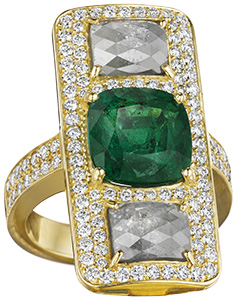|
Colored Gemstone
Green Luck
New emerald finds and marketing campaigns are keeping the classic emerald at the forefront of consumer desire.
By Sheryl Jones
 |
| Lauren K |
In today’s competitive luxury goods market, emeralds remain most desirable and valuable due to their color, allure and rarity. The gemstone’s grass green color has come to symbolize growth and the cycle of rebirth. According to Yaron Nhaissi, managing director of Emco Gem Inc., a Colombian emerald manufacturer and importer, “Emeralds are very popular in many different cultures because of the color. In the Middle East, the color green symbolizes prosperity and growth and it is tradition to give something green for weddings.” He goes on to say, “In India, the Mughal emperors were known for their vast collection and use of emeralds in their jewelry and adornment of daggers, swords, thrones, saddles and so on.”
Where does this spectacular color come from? Emerald gets its color from trace elements of vanadium, chromium and iron. Industry experts say they can easily identify the origin of an emerald just from the color. Nhaissi points out that Colombian emeralds have a warmer, more distinctive color, adding, “They have a beautiful yellowish-green hue that makes it very easy to tell the difference when you compare them side by side to other emeralds.” Gabriella Harvey, director of cut and polished gemstone sales for Gemfields, the largest supplier of Zambian emeralds, says, “Zambian emeralds range in color from a natural, rich, saturated green to a vibrant green with slight bluish undertones.”
Whether a warmer green with yellowish tones or vibrant green with bluish tones, emeralds usually have inclusions — called “le jardin” because they resemble moss or a garden — that can be seen without the aid of a loupe. Since most emeralds have inclusions, they are immersed in oil to minimize their appearance and maximize the dispersion of light. Nhaissi says, “Untreated emeralds amount to much less than 1 percent of all emeralds on the market, which are commonly treated with different types of oils and polymers.” Other people in the industry prefer polymers because oils like cedar wood will dry out after a couple of years. Once the oils dry up they no longer mask the inclusions. However, resin is almost impossible to remove.
These treatments are a source of debate because an emerald’s appearance can look vastly different after being treated with oil and the true nature of the stone is only seen once the oil wears off. Given a treatment’s impact on the real value of the stone, most gem labs will grade the degree of treatment enhancement as part of the report.
Regardless of the treatment, the country of origin of emeralds plays an important role in their value. Some in the industry say the finest emeralds come from Colombia. There are stories throughout history of kings, queens and moguls adorning themselves with emeralds from Colombia brought back by Spanish explorers. For these reasons, they are known as the best and as a result command higher prices. However, Zambian emeralds are becoming very popular, too. Harvey adds, “When Gemfields had its first auction, Zambian emeralds were trailing behind Colombian emeralds. However, Zambian emeralds have increased 16 times in price in the past five years, primarily due to the education and marketing platforms Gemfields initiated. Today the gap between Colombian and Zambian emeralds is very close when looking at market share.”
The rarity of high-quality emeralds also plays an important role in the value. They are more rare than diamonds. According to Nhaissi, “Only a few mines are producing them and not on a consistent basis of what is considered gem quality.” As far as Zambian emeralds, Harvey adds, “High-quality emeralds will always be in demand because of the mining production. Premium emeralds equate to less than 1 percent of production.”
There is also steady demand for emeralds in sizes from 3 carats to 9 carats in cushion, emerald and pear shapes, along with perfectly matched pairs in these shapes. Harvey says they are also seeing marquise and trillions making a comeback. But it is very hard to find high-quality emeralds over 10 carats. There is not enough on the market to meet the demand. Even though these sizes are very hard to find, they are beautiful and rare gemstones that are still more accessible than rubies or sapphires in sizes of 10 carats and larger. As one industry insider explained, a beautiful 20-carat Colombian emerald could be purchased for $300,000, but it would not be possible to get a Kashmir sapphire or Burmese ruby for that price.
The affordability of larger emeralds is why, according to Nhaissi, “It is usually a second purchase after the diamond engagement ring because you can get a bigger stone.” This is why, he says, a more seasoned, savvy, style-conscious buyer who is looking for a less traditional piece of jewelry usually wears an emerald.
Gemfields’ marketing campaign has featured actress Mila Kunis and is targeting a younger audience and first-time buyer who is just as interested in the story behind the stone as in the stone itself. In an effort to be completely transparent in how their mines are run in various countries, they have a core sustainability strategy encompassing responsibility for environmental, societal, human rights and labor issues. Coupled with this strategy, Harvey concludes, the company is “actively seeking out cutting-edge jewelry designers whose modern creations attract the Millennial generation; in fact, we will soon announce a collaboration that will serve that exact purpose. By nurturing young talent we not only help to secure the future careers of young jewelry designers, we can also help introduce fresh concepts to first-time buyers.”Article from the Rapaport Magazine - May 2016. To subscribe click here.
|
|